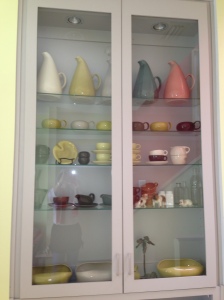To hoard or not to hoard? I am a hoarder: guilty as charged by partners, in-laws, and professional movers. Sunday afternoon I rummaged through the catacombs of crap that my husband and I have crammed into our storage area. Old board games like Battleship, dry rotted pairs of flip flops that I haven’t worn in three years, chess set pieces of naked people in stupid positions, The Riverside Guide to Shakespeare, I mean, just all the flotsam and jetsam we’ve collected through the years that we refused to take to the curb when we moved in January.
Among all the useless stuff was sandwiched what I call my “valuable” stuff; my humongous collection midcentury fabrics, furniture, plasticware, glassware, and by humongous, I mean probably large enough to open my own shop. The creme de la creme of this midcentury mineshaft is my Russel Wright dinnerware.
For nearly a decade, I spent nearly every weekend patrolling antique fairs, flea markets, and garage sales for these pieces. They were designed by Russel Wright between 1939 and 1966 as everyday tableware. American Modern was the first pottery line produced by Russel Wright in 1939, the same year that Benny Goodman’s band brought jazz-inflected swing to Carnegie Hall. American Modern replicated the feeling of swing in its streamlined shapes. Its cutting edge style and solid colors replaced the heavier look of Art Deco and the more ornate, flowery patterns of traditional dinnerware. An aesthetic break with the past, it became the dinnerware of choice for many a young couple.
Most collectors focus on a particular color, and mine was chartreuse, although I ended up with lots of other colors, too, like coral, granite grey, and sea foam, all colors that are specifically reminiscent of picture books and advertisements from that era. (Even though Russel Wright dinnerware has been reissued in recent years, these shades have never been matched.) I infected my boyfriend with my enthusiasm. Soon, he became a greater expert than I, spending hours on the Internet in search of elusive pieces in rare colors. Although RW could become expensive, one piece was rarely over $500, so as collectibles go, it was somewhat affordable, even at the top of the market from 2000 to 2006.
When we moved in together, our collections dominated our small house. Every inch of shelf space was dedicated to formations of biomorphic pitchers, gravy boats, and creamers. We probably owned over 60 dinner plates, and we held a few dinner parties, subjecting guests to lectures about the place settings in front of them. When my partner and I split up after a decade, my pieces were packed and boxed, not to be seen again for another seven years.
In the meantime, I truly owned the fact that I’m an introvert, that the stress of giving dinner parties outweighs the fun, and I thought that I would never have a home large enough to accommodate all the pieces I’d amassed. During the next few moves, I lifted and hauled heavy boxes labelled RW and nearly put them to the curb. Even though they were worth several thousand dollars at least, the freedom from possessions was tempting. About this time, Russel Wright stopped commanding such great prices — even if I were to sell my collection to a dealer or put it on Ebay I would have to unpack so many boxes just to describe what I had! It never seemed worth it.
The house I’m in now is blessed with large built-in shelves. For weeks, the shelves stayed empty and reproached me with their emptiness. Whatever compelled me to finally unpack those boxes is anybody’s guess, but I soon was up to my waist in newspaper, some silverfish, and a few broken pieces. Mostly I felt delight as I lovingly ran my hands over those sleek curves and understood why I wanted them in the first place.
“We love the colors and the sheen that call to mind the past that made them,” says Junichiro Tanizaki. What a beautiful color sea foam is! Sort of a dark aqua or teal, it’s the color of the oceans parted by 1930’s ocean liners in travel posters.
I uncovered other goodies, too, like my Apollo 11 commemorative glasses, and my ancillary dinnerware collections of Starburst and my mom’s Raymond Loewy. I will use this stuff occasionally, but mostly I like to look at it. For me, these objects are aesthetic tokens of the time that America loved speed in all forms, breaking the sound barrier, culminating in the shrieking trumpet of Dizzy Gillespie, and finally orbiting the earth in space.
“The only difference between an extraordinary life and an ordinary one is the extraordinary pleasures you find in ordinary things.”- Veronique Vienne. I know this means everyday experiences like the crunch of buttered toast or watching the day pause on the chilly edge of a spring night. For some of us, though, the objects we surround ourselves with take on a life of their own, a connection between the time they were made and the things we hope to reveal about ourselves by choosing to display them.
My shelves are full of the things I find extraordinarily lovely, and the times in my life that were extraordinary full of love. None of it belongs on the curb.

